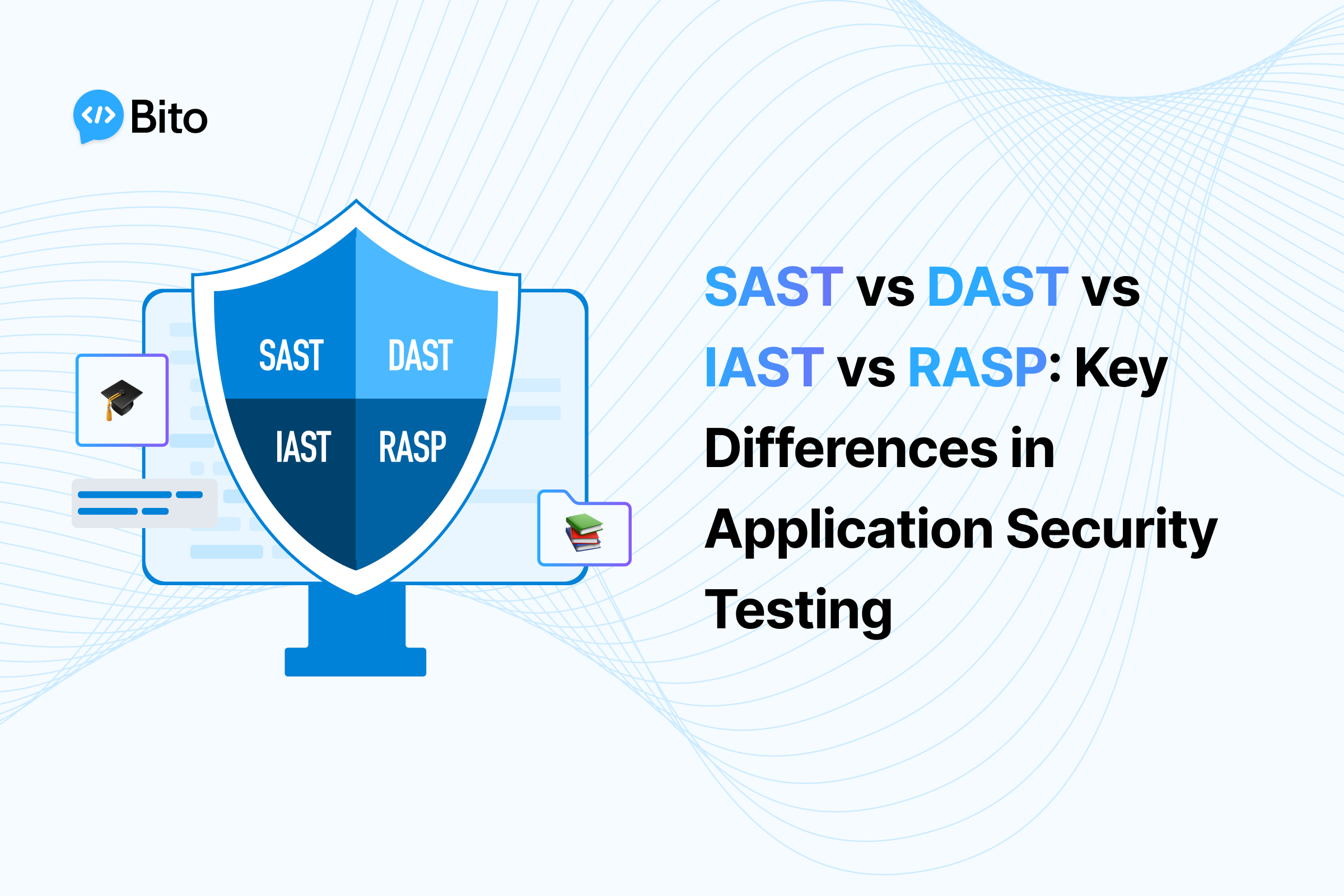Application security is more important than ever as organizations adopt modern software practices like agile development and DevOps. The accelerated pace of releases means there’s increased risk if vulnerabilities aren’t detected early and often. This makes having robust application security testing processes essential.
In this article, we’ll examine the key differences between the four main types of application security testing:
- Static Application Security Testing (SAST)
- Dynamic Application Security Testing (DAST)
- Interactive Application Security Testing (IAST)
- Runtime Application Self-Protection (RASP)
Understanding when to use each approach and how they complement each other will help organizations build comprehensive application security programs. Let’s dive in.
Introduction to Application Security Testing
Application vulnerabilities have become one of the leading causes of data breaches. According to research from Verizon, 43% of data breaches in 2020 were the result of web application attacks, up significantly from 22% in 2019.
With the rise of advanced persistent threats, organizations can no longer rely solely on perimeter defenses like firewalls. Attackers are now targeting the application layer, which often has weaker security controls. Flaws like SQL injection or cross-site scripting create openings for attackers to steal data or take over user accounts.
To protect against these threats, organizations need to test their applications for vulnerabilities and address any issues before deployment. This is where SAST, DAST, IAST, and RASP come in. Each testing approach has strengths and weaknesses, so utilizing a combination tailored to your application and development practices is key for comprehensive security.
Defining the Main Application Security Testing Approaches
Let’s take a deeper look at how each type of testing works and the key differences between them.
Static Application Security Testing (SAST)
SAST, also known as white-box testing, analyzes an application’s source code to find security flaws before runtime. It scans for common vulnerabilities like SQLi, XSS, and buffer overflows that could be exploited if released into production.
SAST solutions scan code for patterns that indicate vulnerabilities. For example:
// SQL Injection Vulnerability
const query = "SELECT * FROM users WHERE id = " + req.query.id;
// Cross-site Scripting Vulnerability
res.render(req.query.page);
Once detected, SAST points developers to the exact lines of code that need to be fixed. This is a key advantage over black-box testing.
The main benefits of SAST include:
- Finds vulnerabilities early in the SDLC when they are cheaper to fix
- Scans entire codebase including custom code, open source libraries, etc.
- Pinpoints location of vulnerabilities in source code
- Allows developers to fix issues before they reach production
- Fast and automated scanning of large codebases
- Integrates into IDEs and CI/CD pipelines
However, SAST also has some limitations:
- Only analyzes static code, so misses runtime vulnerabilities
- Prone to false positives due to lack of runtime context
- Doesn’t detect issues in compiled binaries or runtime environments
Overall, SAST is extremely useful for identifying coding mistakes and enforcing secure development practices. But it should be combined with other testing methods for the most complete coverage.
Dynamic Application Security Testing (DAST)
DAST, also known as black-box testing, analyzes a running application from the outside to find security flaws. It works by simulating attacks against the application and monitoring the responses.
DAST tools crawl the application to discover all available interfaces – things like login pages, APIs, etc. It then launches exploits to test for vulnerabilities like SQLi, XSS, insecure configs, etc.
For example, a DAST tool might submit a login form with `”‘ OR 1=1 –“` as the password to check for SQL injection. If the application is vulnerable, it would log the tester in successfully, allowing them access.
The main advantages of DAST testing are:
- Finds vulnerabilities missed by static testing like improper session handling
- Tests the application in a real-world state, closer to production
- Blackbox approach simulates real attacks effectively
- Broad vulnerability coverage for OWASP Top 10 and beyond
- Useful for testing third-party applications with no source code
Limitations include:
- Only detects surface vulnerabilities, limited internal visibility
- Can be slow running full scans against large applications
- More prone to false positives than whitebox testing
- Doesn’t pinpoint vulnerable code like SAST
DAST provides valuable real-world attack simulation to complement static testing. It should be run against applications in later stages of development as well as periodically against production systems.
Interactive Application Security Testing (IAST)
IAST combines SAST and DAST approaches for hybrid whitebox and blackbox testing. IAST solutions instrument the application code and monitor execution to detect vulnerabilities at runtime.
Like SAST tools, IAST analyzes source code to find issues. But it also monitors runtime execution flows to verify if vulnerabilities can actually be exploited, reducing false positives.
For example, IAST might detect injection points in code but only report ones that are actually reachable through normal use. It also ties findings to specific lines of code.
The main advantages of IAST are:
- Finds issues missed by SAST and DAST alone
- Analyzes attacks within running application for accuracy
- Low false positive rate due to runtime insight
- Ties findings to exact vulnerable code locations
- Integrates into CI/CD pipeline like SAST
Drawbacks include:
- More complex to implement than SAST or DAST alone
- Requires application instrumentation for full benefits
- Can have significant performance overhead
- Only protects instrumented application code
Overall, IAST provides a powerful combination of static + dynamic analysis. It is a valuable addition for organizations using SAST and DAST to strengthen defenses.
Runtime Application Self-Protection (RASP)
RASP takes a different approach than the previous testing tools. Rather than scanning for vulnerabilities, RASP instruments the application to monitor activity at runtime and actively block attacks.
RASP solutions are embedded into applications to analyze all traffic in real-time, build profiles of normal behavior, and detect threats. For example, RASP can identify and block SQL injection payloads sent to the application.
This enables RASP to provide runtime protection against both known and zero-day threats. It can also be effective against logic flaws IAST or DAST may not detect statically.
Key advantages of RASP include:
- Real-time attack protection for running applications
- Detects and blocks both known and zero-day threats
- Flexible implementation as library, agent, or network proxy
- Low performance impact with optimized rule tuning
- Detects threats based on behavior rather than signatures
Limitations:
- Not a complete replacement for SAST/DAST testing
- Risk of performance overhead or false positives if not tuned
- Protects only instrumented application code
- Skilled configuration required for effective protection
RASP complements testing tools by providing runtime self-defense capabilities. It is a valuable addition to fortify critical applications against sophisticated threats.
Comparing SAST vs DAST vs IAST vs RASP
Now that we’ve looked at each type of application security testing in depth, let’s directly compare their pros and cons.
| SAST | DAST | IAST | RASP | |
| How it Works | Analyzes source code for vulnerabilities | Tests running application by simulating attacks | Instruments code and monitors execution to find vulnerabilities | Embedded in app to monitor activity and block attacks at runtime |
| When Used | Early in development, pre-release | Later development, QA, production | Development through production | Production |
| Testing Type | Whitebox | Blackbox | Greybox | N/A |
| Benefits | Finds issues early, pinpoints vulnerable code, scans entire codebase quickly | Tests real-world attack vectors, finds runtime issues | Combines SAST + DAST, highly accurate, integrates with CI/CD | Runtime protection against known and zero-day threats |
| Limitations | Only analyzes static code, prone to false positives | Limited visibility, prone to false positives, slow | Complex setup, resource intensive | Not a complete testing solution, risk of performance impact |
As shown, each methodology has strengths and weaknesses. SAST offers the earliest and most actionable feedback but can’t catch all flaws. DAST finds real-world weaknesses but lacks code context. IAST combines both for accuracy but needs proper implementation. RASP provides runtime defense but still needs good testing practices.
Utilizing a combination of these techniques is the most effective application security strategy. Where you apply each depends on your development practices, risk tolerance, and resources.
Integrating Application Security Testing into DevOps Pipelines
To achieve maximum benefit, organizations should integrate application security testing into their DevOps toolchain and workflows.
With modern agile practices, code is constantly changing which means vulnerabilities can be introduced at any time. Testing needs to be repeated early and often, especially for critical applications.
Here are some tips on integrating security testing into DevOps pipelines:
- Perform SAST scans during development – Scan code on every commit or pull request to identify issues when they are cheapest to fix. Block merges or auto-assign tickets when policy violations are found.
- Run DAST against staging environments – Scan running applications after major releases to catch flaws missed by SAST. Help developers understand real-world exposure.
- Shift Left Security – Move testing earlier in development lifecycle. Don’t wait for dedicated security phases.
- Prioritize critical applications – Focus testing on applications handling sensitive data or mission-critical to the business.
- Automate testing– Leverage CI/CD tools to run scans and tests automatically whenever code changes.
- Promote security hygiene – Make secure coding practices part of developer workflow. Provide training, resources, and feedback from testing tools.
- Don’t rely on one technique – Utilize a combination of SAST, DAST, and IAST tailored to your needs for optimal coverage.
- Include RASP where needed– Deploy runtime protection for high-risk applications as an added defense layer.
- Integrate with ticketing systems – Auto-generate tickets for developers from failed tests to streamline remediation.
- Provide security KPIs– Track testing coverage, open tickets, and other metrics to quantify progress.
By following these practices, organizations can build security into their development pipelines versus leaving it as an afterthought. This results in more secure code being released at velocity.
Conclusion
With the rising frequency of application security incidents, having robust testing methodologies in place is crucial. SAST, DAST, IAST, and RASP each play an important role in securing the software development lifecycle.SAST offers the fastest feedback by scanning source code but can’t catch all flaws. DAST tests applications like a real attacker but with limited visibility. IAST combines SAST and DAST for accuracy but needs proper implementation. RASP provides runtime protection to complement testing.
The most effective application security strategy utilizes a combination of these techniques integrated into the development toolchain. This empowers developers to find and fix vulnerabilities early while providing defense-in-depth for production systems. Organizations that take the time to understand these application security testing approaches will be well-positioned to release secure software at the pace demanded by the market.






